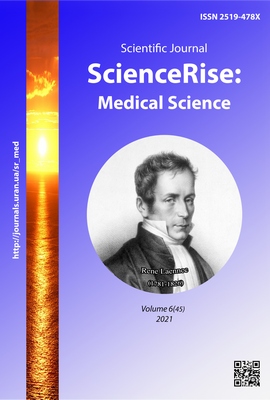Influence of complex treatment on the functional state of the hepatobiliary system in patients with diabetes mellitus
DOI:
https://doi.org/10.15587/2519-4798.2021.250144Keywords:
diabetes mellitus, hepatobiliary system, ursodeoxycholic acid, ultrasound, alanine aminotransferase, aspartate aminotransferaseAbstract
Liver damage in diabetes mellitus is of particular interest, since this factor significantly affects the course of the disease, the level of compensation and prognosis of the underlying disease.
The aim. To study the effect of complex treatment using ursosan on the functional state of the hepatobiliary system in patients with diabetes mellitus.
Materials and methods. The study included 30 patients with type 1 diabetes mellitus and 48 patients with type 2 diabetes. According to the duration of diabetes, patients were divided into three subgroups: a) up to five years; b) 5–10 years; c) more than 10 years. The number of patients was: 1a group – 13, 1b group – 10, 1c group – 7 people; Group 2a – 23, 2b group – 13, 2c group – 10 people. The control group consisted of 23 apparently healthy people. Ursosan was prescribed at a dose of 10-12 mg per 1 kg of body per day for 6 months. Clinical laboratory and instrumental research methods were used to study the functional state of the liver and gallbladder.
Research results. After the course of treatment with Ursosan, patients with diabetes mellitus showed normalization of protein, pigment, enzymatic metabolism and, to a lesser extent, lipid metabolism in the liver, which led to an improvement in cellular metabolism and redox processes, providing a stable course of diabetes.
Conclusions. A 6-month course of treatment with Ursosan in diabetic patients promotes long-term diabetes compensation. Patients during treatment have a decrease in cytolysis syndrome indicators (alanine aminotransferase (AlAT), aspartate aminotransferase (AsAT), lactate dehydrogenesis (LDH)) by about 1.5 times in all 3 indicators compared to the indicators before treatment. The same trend was observed in terms of gamma-glutamine transferase (GGT) and alkaline phosphatase (ALP)
References
- Saeedi, P., Petersohn, I., Salpea, P., Malanda, B., Karuranga, S., Unwin, N. et. al. (2019). Global and regional diabetes prevalence estimates for 2019 and projections for 2030 and 2045: Results from the International Diabetes Federation Diabetes Atlas, 9th edition. Diabetes Research and Clinical Practice, 157, 107843. doi: http://doi.org/10.1016/j.diabres.2019.107843
- Wild, S., Roglic, G., Green, A., Sicree, R., King, H. (2004). Global Prevalence of Diabetes: Estimates for the year 2000 and projections for 2030. Diabetes Care, 27 (5), 1047–1053. doi: http://doi.org/10.2337/diacare.27.5.1047
- Egorova, E. G., Ilchenko, L. Iu. (2005). Pechen i metabolicheskii sindrom. Gepatologiia, 4, 28–35.
- Wajchenberg, B. L. (2007). β-Cell Failure in Diabetes and Preservation by Clinical Treatment. Endocrine Reviews, 28 (2), 187–218. doi: http://doi.org/10.1210/10.1210/er.2006-0038
- Cabrera, D., Arab, J. P., Arrese, M. (2019). UDCA, NorUDCA, and TUDCA in Liver Diseases: A Review of Their Mechanisms of Action and Clinical Applications. Handbook of Experimental Pharmacology. Cham: Springer, 237–264. doi: http://doi.org/10.1007/164_2019_241
- Vakhrushev, Ia. M., Gorbunov, A. Iu. (2013). Comparative evaluation of various methods of conservative therapy of early stage of cholelithiasis. Experimental and Clinical Gastroenterology, 6, 7–10.
- Zhang, Y., Jiang, R., Zheng, X., Lei, S., Huang, F., Xie, G. et. al. (2019). Ursodeoxycholic acid accelerates bile acid enterohepatic circulation. British Journal of Pharmacology, 176 (16), 2848–2863. doi: http://doi.org/10.1111/bph.14705
- Goldstein, J., Levy, C. (2018). Novel and emerging therapies for cholestatic liver diseases. Liver International, 38 (9), 1520–1535. doi: http://doi.org/10.1111/liv.13880
- Xiang, Z., Chen, Y., Ma, K., Ye, Y., Zheng, L., Yang, Y. et. al. (2013). The role of Ursodeoxycholic acid in non-alcoholic steatohepatitis: a systematic review. BMC Gastroenterology, 13 (1). doi: http://doi.org/10.1186/1471-230x-13-140
- Angelin, B., Nilsell, K., Einarsson, K. (1986). Ursodeoxycholic acid treatment in humans: effects on plasma and biliary lipid metabolism with special reference to very low density lipoprotein triglyceride and bile acid kinetics. European Journal of Clinical Investigation, 16 (2), 169–177. doi: http://doi.org/10.1111/j.1365-2362.1986.tb01325.x
- Bouscarel, B., Fromm, H., Ceryak, S., Cassidy, M. M. (1991). Ursodeoxycholic acid increases low-density lipoprotein binding, uptake and degradation in isolated hamster hepatocytes. Biochemical Journal, 280 (3), 589–598. doi: http://doi.org/10.1042/bj2800589
- Vakhrushev, Y. M., Lukashevich, A. P., Penkina, I. A., Suchkova, E. V. (2019). Comparative analysis of bile acid spectrum in non-alcoholic fatty liver disease and cholelithiasis. Terapevticheskii Arkhiv, 91 (2), 48–51. doi: http://doi.org/10.26442/00403660.2019.02.000105
- Coupaye, M., Calabrese, D., Sami, O., Siauve, N., Ledoux, S. (2019). Effectiveness of Ursodeoxycholic Acid in the Prevention of Cholelithiasis After Sleeve Gastrectomy. Obesity Surgery, 29 (8), 2464–2469. doi: http://doi.org/10.1007/s11695-019-03862-z
- Butorova, L. I., Ardatskaya, M. D., Osadchuk, M. A., Drobysheva, A. E., Zagrebina, E. A., Kadnikova, N. G. et. al. (2020). Comparative effectiveness of ursodeoxycholic acid preparations in the treatment of biliary sludge. Terapevticheskii Arkhiv, 92 (8), 60–65. doi: http://doi.org/10.26442/00403660.2020.08.000700
Downloads
Published
How to Cite
Issue
Section
License
Copyright (c) 2021 Gunay Adalat Valiyeva

This work is licensed under a Creative Commons Attribution 4.0 International License.
Our journal abides by the Creative Commons CC BY copyright rights and permissions for open access journals.
Authors, who are published in this journal, agree to the following conditions:
1. The authors reserve the right to authorship of the work and pass the first publication right of this work to the journal under the terms of a Creative Commons CC BY, which allows others to freely distribute the published research with the obligatory reference to the authors of the original work and the first publication of the work in this journal.
2. The authors have the right to conclude separate supplement agreements that relate to non-exclusive work distribution in the form in which it has been published by the journal (for example, to upload the work to the online storage of the journal or publish it as part of a monograph), provided that the reference to the first publication of the work in this journal is included.









